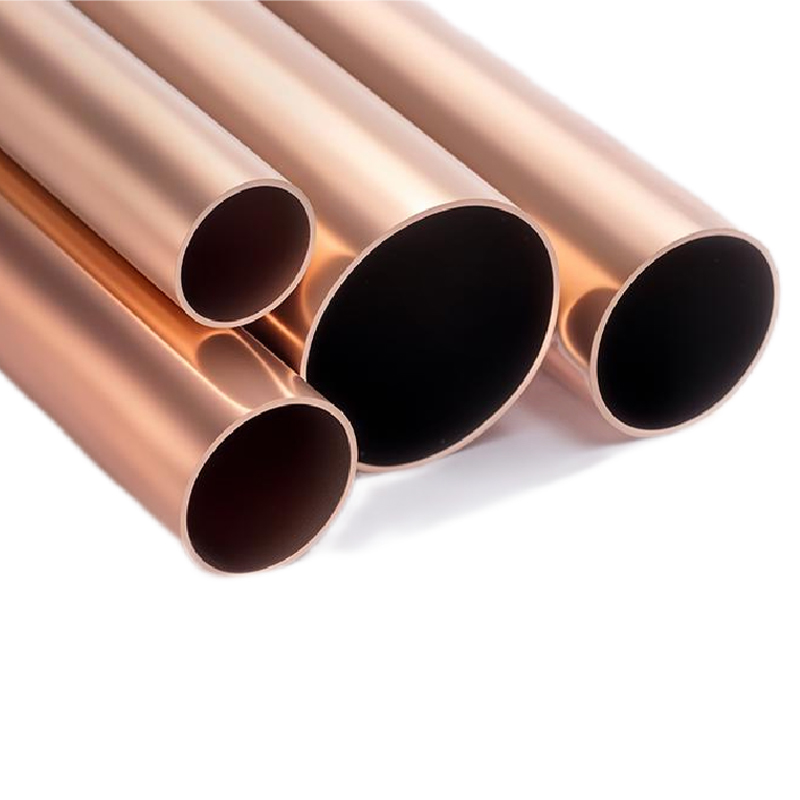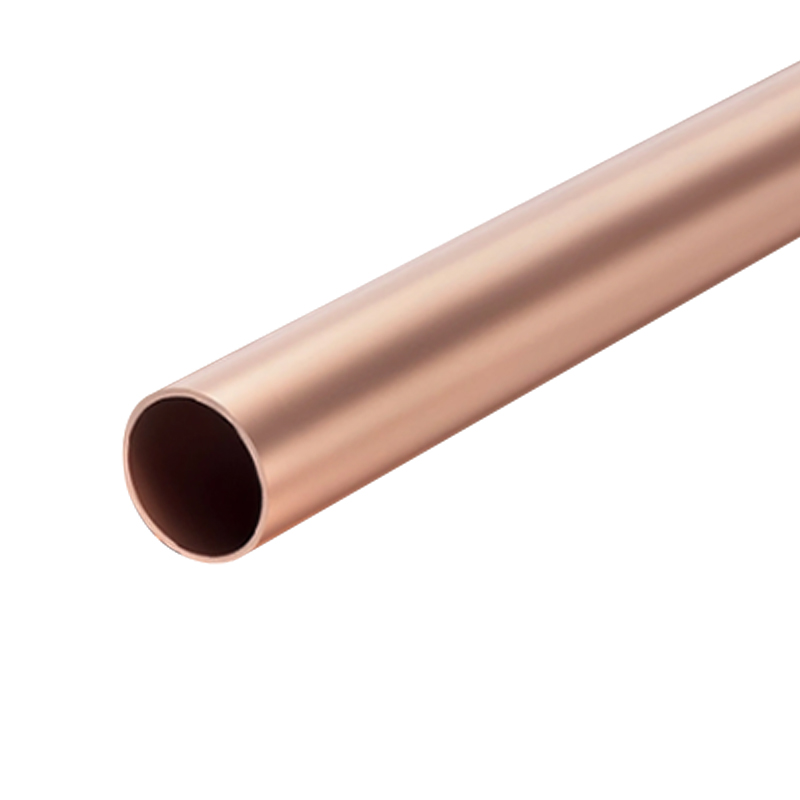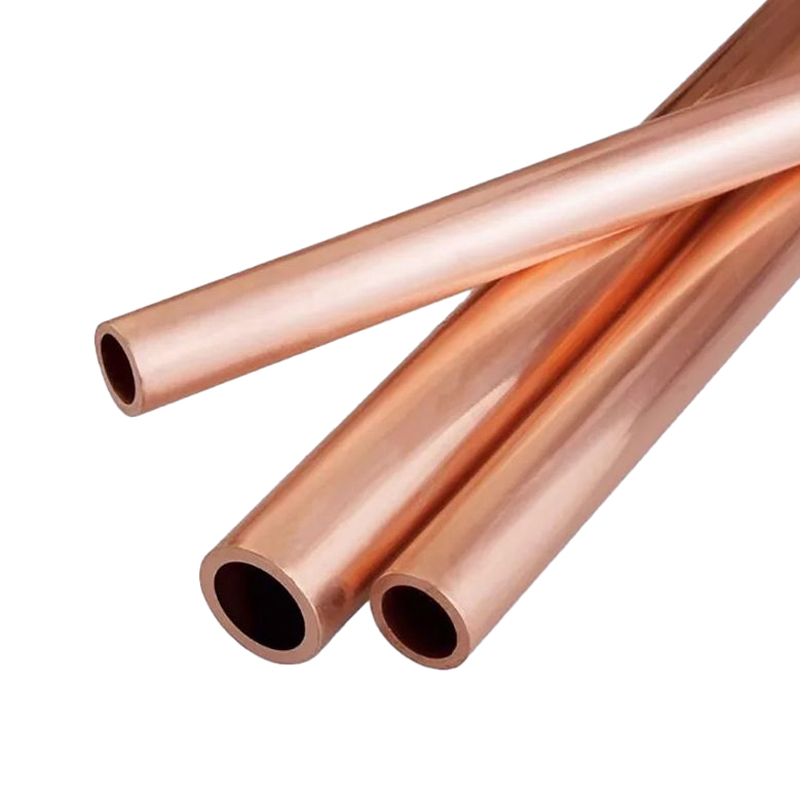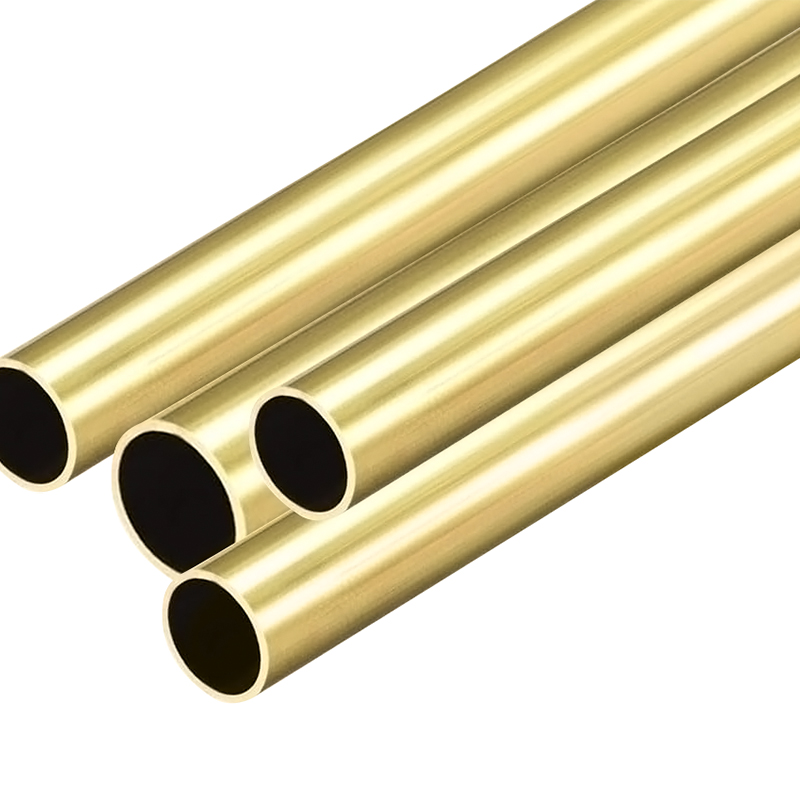The Copper Water Tube produced by our company is a high-performance copper tube suitable for hot and cold water systems and heating applications. It has significant advantages such as natural antibacterial, corrosion resistance, environmental protection, and recyclability. The copper ions in the copper material can effectively destroy the bacterial cell membrane, degrade its DNA/RNA, and kill 99% of E. coli and Legionella within 5 hours. Its antibacterial performance far exceeds that of traditional plastic tubes. The World Health Organization (WHO) has also certified that the copper surface can inactivate the coronavirus within 2 hours, fully reflecting its important value in health protection. The service life of this product can reach 100 years, which not only ensures water quality safety but also reduces maintenance costs. At the same time, the recovery rate is close to 99.99%, which is in line with the environmental protection concept of sustainable development. Copper water tubes are widely used in hot and cold water tube systems in high-end residences, hospitals, hotels, and other places. It is also suitable for air conditioning condenser connection tubes and ground source heat pump buried heat exchange tubes in refrigeration and heating systems.
ABOUT US
30+YEARS OF
EXPERIENCE
About Us
A Reliable Partner of the Copper Tube Industry
Zhejiang Jingliang Copper-Tube Products Co., Ltd established in 1994, is China Copper Water Tube Manufacturers and Custom Copper Water Tube Suppliers, has been deeply involved in the copper tube industry for over three decades. The company primarily produce various specifications of products such as copper tubes, brass tubes, copper square tubes, fin copper tubes, copper capillary tubes, condenser copper tubes, copper evaporator tubes, and conductive rods, which are of quality and have earned the trust and acclaim of customers both domestically and internationally.
Wide Applications:
These products are widely used in various fields including air conditioning, refrigeration, heat exchange, sanitary ware, automotive, machinery, electric furnaces, and chemical industries.
Convenient Transportation:
Strategically located in Tangpu Town, renowned as the “home of copper tubes” in East China. Our company enjoys a prime location, adjacent to the Shangsan Expressway and National Highway 104, and is conveniently situated just over 70 kilometers from Hangzhou and Ningbo, ensuring easy accessibility and a business position.
Strong Financial Resources:
With its strong financial resources and advanced copper tube processing technology, our company holds an advantageous position in market share, brand value, technological content, and product quality, becoming a preferred supplier for many listed groups.
Large Scale Production:
The company occupies an area of over 20,000 square meters, with a construction area of 12,800 square meters. In 2022, our annual production exceeded 7,500 tons, with a value output of up to 450 million yuan, demonstrating our strong production capacity and market competitiveness.
Comprehensive Industry Chain:
Jingliang has now developed into a complete industrial chain integrating smelting, extrusion, drawing, precision rolling, and annealing. It has been awarded multiple honors, including "Top Ten Copper Tube Enterprises" and "Leading Taxpayer in the Copper Tube Industry".
Smart Manufacturing:
Jingliang Copper-Tube Products will better integrate the concept of factory construction into its corporate development strategy, insist on refining technology and polishing products more finely, and the future of "intelligent manufacturing".
Genuine Cooperation:
Zhejiang Jingliang Copper-Tube Products Co.,Ltd warmly welcomes friends from all walks of life to visit and offer guidance. We look forward to joining hands with you to create a brilliant future together.
Technical skills
Production Process
- 1、Electrolytic Copper
- 2、Copper Ingots
- 3、Press
- 4、Drawing
- 5、Rolling
- 6、Packaging
Electrolytic copper, produced through electrolytic processes, is a high-purity copper with good electrical conductivity and thermal conductivity, making it an ideal material for manufacturing copper pipes.
This marks the beginning of our production process, which involves the fabrication of electrolytic copper into pure copper or brass ingots according to specific requirements, followed by cutting to facilitate subsequent processing and handling.
In the pressing stage, the cut copper ingots are pressed into thin sheets or tubular shapes, forming the initial tube shape, and the copper ingots are prepared for drawing and rolling.
Drawing is the process of further processing the copper sheets or tubular objects that have been pressed into the required dimensions and shapes. Through drawing, our copper tubes can achieve precise outer diameters and wall thicknesses.
Rolling is the step of further processing the copper tubes after drawing. Through rolling, the copper tubes are rolled into more precise dimensions and shapes to meet the requirements of different applications.
Finally, the copper tubes that have undergone rolling will be packaged and prepared for shipping. We ensure that the packaging is safe and protective to prevent damage during transportation.
News
-
Copper Tube Industry Segmentation Report: How Are Niche Markets Reshaping the Competitive Landscape?
Subtitle: While traditional copper tubes grapple with price wars, segments like semiconductor-grade oxygen-free copper tubes and ultra-thin wall tubes for new energy vehicles achieve 30%+ gross margins—how do these niche products, represent...
READ MORE -
In the world of heat exchangers, air conditioning systems, refrigeration units, and other thermal management applications, the choice of materials for the tubes that facilitate heat transfer is crucial. Copper and aluminum are two of the mo...
READ MORE -
Refrigeration systems are essential in modern-day life, from preserving food and medicine to maintaining the comfort of our homes and workplaces. One of the key components that ensure the efficient operation of these systems is the capillar...
READ MORE
Industry knowledge
How to avoid electrochemical corrosion during the installation of copper water tubes
Copper water tubes are widely used in water supply systems such as residential, commercial buildings, and industrial piping due to their excellent thermal conductivity, corrosion resistance, high temperature resistance, and good machinability. However, even though copper itself has natural corrosion resistance, in certain application environments, if it is improperly installed or the electrochemical reaction between materials is not considered, it may also cause electrochemical corrosion, thereby affecting the system life and operational safety.
Zhejiang Jingliang Copper-Tube Products Co., Ltd. has been focusing on the copper tube industry for more than 30 years since its establishment in 1994. The company's products cover copper water tubes, brass tubes, copper square tubes, finned copper tubes, capillary copper tubes, condenser copper tubes, evaporator copper tubes, and conductive rods. They are widely used in HVAC, heat exchange equipment, sanitary ware, automobiles, machinery, electric furnaces, and chemical industries, and have won high recognition from customers at home and abroad.
The nature and causes of electrochemical corrosion
Electrochemical corrosion refers to the phenomenon that micro-batteries are formed in humid or conductive media due to the difference in potential between different metal materials, resulting in local corrosion. Specifically in the installation of copper water tubes, common causes include:
Direct contact between copper tubes and dissimilar metals such as iron and aluminum;
Continuous moisture or condensed water in the system;
Too much chloride ions, sulfides or other corrosive ions in the water quality;
Underground laying without good insulation or protective layer;
No effective potential isolation or improper grounding treatment in the tubeline system.
Key measures to prevent electrochemical corrosion in the installation of copper water tubes
1. Avoid direct contact between copper tubes and dissimilar metals
During the installation process, direct contact between copper tubes and metals such as aluminum tubes, galvanized steel tubes, and iron parts should be avoided as much as possible. If it is unavoidable, insulating gaskets, plastic sheaths or rubber sleeves should be used as intermediaries to isolate the direct electrical contact between the two metals and inhibit the formation of galvanic corrosion from the root.
2. Reasonable design of water flow direction and metal arrangement order
Follow the design principle of "precious metals connected downstream and base metals connected upstream". For example, in the system, if the copper tube is connected to the iron tube, it should be ensured that the water flows through the iron tube first and then enters the copper tube to avoid the risk of "iron-copper-iron" closed-loop corrosion.
3. Control and optimize water quality
High chloride ion concentration and high hardness water will aggravate the corrosion of copper tubes. When designing, it should be considered to install central water treatment equipment or softeners to stabilize water quality, reduce corrosive ion concentrations, and extend the service life of the system.
4. Strengthen grounding and lightning protection systems
The copper water tube system should have a good grounding system and avoid it becoming a "conductor" of the building's lightning protection system. In terms of design, electrical isolation measures can be taken to ensure that the copper tube does not conduct current and prevent corrosion caused by potential difference.
5. Buried copper tubes should be well protected
For buried water supply systems, PE sheathed copper tubes or external insulating coatings should be used to prevent corrosive substances in the soil from corroding the copper tubes. At the same time, it is necessary to avoid contact between copper tubes and steel bars in reinforced concrete to reduce the internal galvanic corrosion environment.
6. Use high-quality copper materials and advanced processing technology
The quality of the copper tube itself is directly related to its corrosion resistance. Relying on the layout of the entire industrial chain, Zhejiang Jingliang adopts advanced precision drawing, vacuum annealing and surface passivation treatment technology to ensure that each copper tube has high purity, low impurities, high-density grain structure, and performs well in chemical stability and corrosion resistance.
What should be paid attention to in the transportation and storage of copper water tubes to prevent damage
As a key tube widely used in HVAC, refrigeration equipment, heat exchangers, automotive tubelines, chemical supporting systems and other fields, the product quality of copper water tubes depends not only on technical control in the manufacturing stage, but also on standardized management of the transportation and storage process. Although copper has excellent ductility and corrosion resistance, if appropriate protective measures are not taken in the handling, loading, stacking and other links, it is very easy to cause deformation, scratches, contamination or corrosion, thereby affecting subsequent installation and service life.
Key protective measures in the transportation link
From the production line to the hands of customers, copper water tubes usually need to go through multiple links such as loading and unloading, short-distance transportation, transit storage and terminal distribution. The following are the "four key points" of transportation damage prevention summarized by Zhejiang Jingliang:
1. Use special packaging methods
Zhejiang Jingliang uses carton packaging, woven bag bundling, foam support, wooden box packaging and other methods according to different product types, and adds anti-pressure corner guards and anti-collision strips on the outside to effectively prevent the tube body from being dented or deformed due to impact during transportation, especially for capillary copper tubes and thin-walled soft copper tubes.
2. Prevent metal surface scratches
The surface of copper is soft and can be easily scratched by metal, tools or the ground. To avoid such surface damage, Zhejiang Jingliang requires transportation workers to wear gloves without sharp edges, use rubber hooks and soft rope lifting equipment, and avoid direct contact with steel and sharp objects during handling and loading and unloading.
3. Strictly control the stability of loading
The loading link is a high-risk area for copper tube damage. Zhejiang Jingliang uses layered reinforcement, rubber pad isolation, and limit devices to ensure that the copper tube does not move or roll during transportation, especially in long-distance transportation, which can effectively reduce problems such as tube end collision and skew caused by bumpy road conditions.
4. Full waterproof and dustproof protection
Copper materials are exposed to rain or humid air, which is very prone to surface oxidation, discoloration or corrosion. For this reason, Zhejiang Jingliang covers the entire process with PE waterproof film or heat shrink plastic sealing material before transportation, and marks "moisture-proof", "pressure-proof", "light" and other eye-catching signs on the packaging to ensure that all parties in logistics are fully aware of the protection requirements.
Scientific management methods during storage
After the copper water tube arrives at the customer's warehouse or construction site, if it is not stored properly, it will also cause corrosion, bruises or physical deformation. For this reason, Zhejiang Jingliang specifically recommends storage protection from the following aspects:
1. Choose a dry and ventilated storage environment
The storage place must avoid corrosive environments such as humidity, high salt fog, and acidic gases. Copper tubes should be stacked off the ground, with wooden boards or moisture-proof pads underneath to avoid direct contact with the concrete floor.
2. Strictly distinguish product types
Copper water tubes of different specifications, models and batches should be managed in different areas and clearly marked to prevent misuse or mismatching at the construction site from causing damage. In addition, capillaries, soft tubes and thin-walled tubes should avoid heavy stacking to avoid elliptical deformation.
3. Regular inspections and rotating inventory
Although copper water tubes have a long storage period, they may still be slightly oxidized due to changes in humidity and temperature differences during long-term storage. Zhejiang Jingliang recommends that customers check the inventory status regularly and rotate the inventory reasonably according to the "first in, first out" principle, giving priority to old batches of products.

 English
English Español
Español




